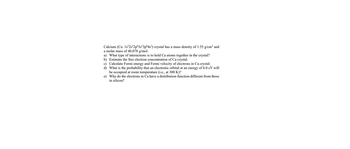Calcium (Ca: 1s²2s²2p 3s 3p 4s²) crystal has a mass density of 1.55 g/cm³ and a molar mass of 40.078 g/mol. a) What type of interactions is to hold Ca atoms together in the crystal? b) Estimate the free electron concentration of Ca crystal. c) Calculate Fermi energy and Fermi velocity of electrons in Ca crystal. d) What is the probability that an electronic orbital at an energy of 6.0 eV will be occupied at room temperature (i.e., at 300 K)? e) Why do the electrons in Ca have a distribution function different from those in silicon?
Thermochemistry
Thermochemistry can be considered as a branch of thermodynamics that deals with the connections between warmth, work, and various types of energy, formed because of different synthetic and actual cycles. Thermochemistry describes the energy changes that occur as a result of reactions or chemical changes in a substance.
Exergonic Reaction
The term exergonic is derived from the Greek word in which ‘ergon’ means work and exergonic means ‘work outside’. Exergonic reactions releases work energy. Exergonic reactions are different from exothermic reactions, the one that releases only heat energy during the course of the reaction. So, exothermic reaction is one type of exergonic reaction. Exergonic reaction releases work energy in different forms like heat, light or sound. For example, a glow stick releases light making that an exergonic reaction and not an exothermic reaction since no heat is released. Even endothermic reactions at very high temperature are exergonic.
please answer part a, part b and part c

Step by step
Solved in 4 steps

please show the step clearly









